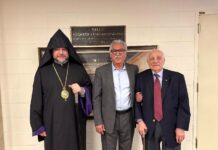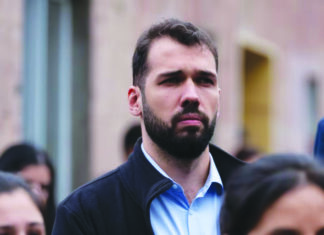By Aram Arkun
Mirror-Spectator Staff
NEW YORK — Architectural model-making requires the vision of an artist and the skill of a craftsman. It has been practiced for centuries, but in recent years technological advances have transformed it greatly. Despite the demanding combination of skills required, most master model- makers do not have a formal university education in this field and come to it in different ways.
Richard Dikran Tenguerian, based in New York City, is one of a small group of elite practitioners in this field whose services are in demand throughout the world. Over the decades he has produced so many projects that it is hard even for him to keep track of them all. His models have been integral to the success of the building of the new Yankee Stadium, the South Street Seaport Museum and interior work for Zankel Hall at Carnegie Hall, all in New York City; the Comcast Center, the tallest building in Philadelphia and many other projects throughout the United States. He has worked with American and foreign architects on international projects in places like Singapore, Taiwan, Moscow, Paris, Dubai, Japan, Kuwait City, Tabriz, Saudi Arabia (the Kingdom Center), various parts of Latin America and South Korea (the Samsung Center). Many of these projects are models of headquarters for large corporations or shopping centers. Tenguerian has worked with and has been praised by prominent architects such as Philip Johnson, Bernard Tschumi, Robert Venturi, Aldo Rossi, Robert A. M. Stern and Emilio Ambasz, as well as many major architectural firms.
For some projects he only needs to prepare relatively small sections of a building, like part of one wall, one tower, interiors or exteriors, while in other cases he must prepare an entire building or a huge complex, with landscaping. The amount of details reproduced depend on the size and nature of the project. Some models are built to help in the development of the idea for an architectural project, while others are used to sell the project to investors or buyers.
What Tenguerian does sounds like fun, but is hard work. He says that people always tell him “you are lucky — you are a grownup still playing with toys. But it is not that simple. There are not many model- makers around, and this is for a reason. The work requires long hours and the readiness to face constant pressure, deadlines and stress. Architects challenge you to make changes, and you must be ready for any surprise. Vacations may get canceled. You have to love this profession and have it in your blood.” It should be added that unlike most toys, the models that Tenguerian builds can range in cost from the tens to the hundreds of thousands of dollars.
Tenguerian, descended from a family of Ottoman-Armenian notables, grew up in Aleppo and benefited from parents who provided a fertile artistic environment. As partial evidence, one of his brothers, Haroutioun, became a sculptor.








